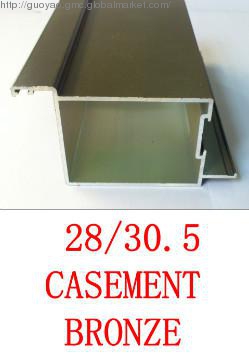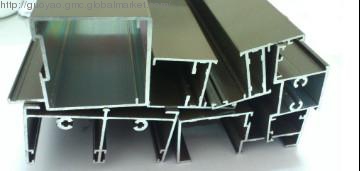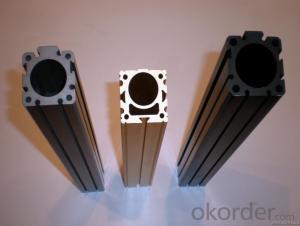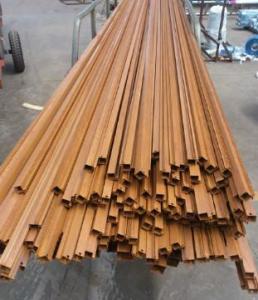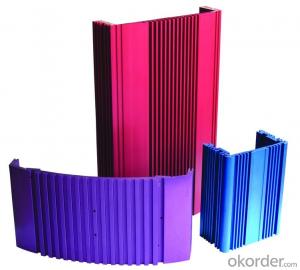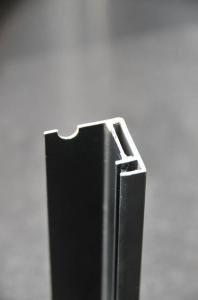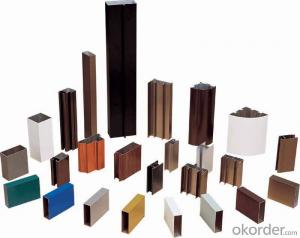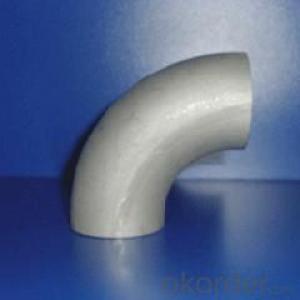Aluminum Profiles for South African Market - Canada
- Loading Port:
- China Main Port
- Payment Terms:
- TT OR LC
- Min Order Qty:
- -
- Supply Capability:
- -
OKorder Service Pledge
Quality Product, Order Online Tracking, Timely Delivery
OKorder Financial Service
Credit Rating, Credit Services, Credit Purchasing
You Might Also Like
we have been focusing on South African Markt
Matrial: 6063 T5/T6
surface:anodze and power coatin
Aluminium Profile
we have been focusing on South African Markt and have been working with SA customers
Matrial: 6063 T5/T6
surface:
Anodze 15/20 mircons
Power coating 70 mircons
Color: white, bronze and charcoal
- Q: What unique considerations or criteria must be met when installing aluminum profiles to ensure they are correctly installed?
- <p>Yes, there are special requirements for installing aluminum profiles correctly. These include ensuring the profiles are of the correct size and specifications for the intended application, proper alignment to maintain structural integrity, and secure fastening to prevent movement or damage. Additionally, it's crucial to follow the manufacturer's guidelines for installation, which may include specific torque settings for screws or bolts, and to consider environmental factors such as temperature and humidity that could affect the profile's performance over time. Proper installation also involves checking for any damage or defects in the profiles before installation and ensuring that all components are compatible with each other.</p>
- Q: Can aluminum profiles be utilized in creating distinctive architectural structures?
- <p>Yes, aluminum profiles can be used to create unique architectural designs. They are favored for their strength, lightweight, and corrosion resistance. Architects can utilize aluminum's flexibility to design complex structures, such as intricate facades, modern window systems, and innovative support frameworks. Aluminum's adaptability allows for both functional and aesthetically pleasing designs, making it a popular choice in contemporary architecture.</p>
- Q: Are aluminum profiles suitable for use as exterior wall materials?
- <p>Yes, aluminum profiles can be used for exterior walls. They are known for their durability, resistance to weathering, and low maintenance requirements. Aluminum is lightweight, strong, and can be easily shaped into various designs. It also has excellent resistance to corrosion, making it ideal for outdoor applications. Additionally, aluminum profiles can be powder coated or anodized for enhanced protection and aesthetic appeal, allowing them to blend well with different architectural styles.</p>
- Q: Is aluminum factory harmful to people?
- While the surface processing some chemical reagents are toxic, water recycling and environmental protection equipment not on emissions, pollution made difficult to recover on the soil and water resources, serious impact on the food chain, eventually the crisis of human survival.
- Q: What are the different types of brackets used with aluminum profiles?
- Aluminum profiles are commonly accompanied by various types of brackets that serve different purposes and aid in the construction of robust structures. Some of the frequently employed brackets for aluminum profiles include: 1. Corner brackets: These L-shaped brackets enable a sturdy connection between two aluminum profiles at a 90-degree angle. 2. T-slot nuts: These specialized nuts are designed to fit into the T-slots of aluminum profiles, facilitating the attachment of accessories like panels, hinges, or locks. 3. Angle brackets: They allow for connections between aluminum profiles at angles other than 90 degrees and can be adjusted to accommodate different angles. 4. Joining plates: Used to connect multiple aluminum profiles end-to-end, these plates ensure a secure connection and maintain the structural integrity of the profiles. 5. Gusset brackets: Triangular in shape, gusset brackets reinforce the connections between aluminum profiles, adding extra strength and stability, especially at joints. 6. Panel brackets: These brackets are employed to attach panels or sheets to aluminum profiles. They typically feature a slot or groove for easy insertion and secure attachment of panels. 7. Mounting brackets: Used for attaching aluminum profiles to walls, floors, or other surfaces, mounting brackets provide a secure mounting point, allowing stable structures to be created. These examples represent just a few of the bracket options available for aluminum profiles. The specific type of bracket required will depend on the intended application and the desired structure to be constructed using the aluminum profiles.
- Q: Are aluminum profiles suitable for signage and advertising displays?
- Yes, aluminum profiles are highly suitable for signage and advertising displays. Aluminum is a lightweight and durable material that is resistant to corrosion, making it ideal for outdoor applications. It can withstand various weather conditions without losing its structural integrity, ensuring longevity and reliability for signage and advertising displays. Additionally, aluminum profiles offer versatility in design and customization. They can be easily shaped and molded into different forms and sizes, allowing for the creation of eye-catching and unique displays. Aluminum profiles also provide a sleek and modern appearance, adding a professional touch to any signage or advertising display. Furthermore, aluminum profiles are highly compatible with other materials commonly used in signage and advertising, such as acrylic, PVC, and LED lighting. This compatibility allows for the integration of different elements, such as illumination, to enhance the visibility and impact of the displays. Moreover, aluminum profiles offer easy installation and maintenance. They can be easily assembled, disassembled, and reconfigured as needed. Their lightweight nature makes them easy to handle, reducing installation time and costs. Additionally, aluminum profiles require minimal maintenance, as they do not rust or deteriorate easily. In conclusion, aluminum profiles are an excellent choice for signage and advertising displays. They offer durability, versatility, compatibility, and ease of installation and maintenance. Whether for outdoor or indoor applications, aluminum profiles can provide a visually appealing and long-lasting solution for effective signage and advertising.
- Q: Features of aluminum profiles
- Thermal conductivityThe thermal conductivity of aluminum alloy is about 50-60% of copper, which is beneficial to the manufacture of heat exchangers, evaporators, heating appliances, cooking utensils, and the cylinder head and radiator of automobiles.FerromagnetismAluminum is non ferromagnetic, which is an important feature of the electrical and electronic industries. Aluminum can not be spontaneous combustion, which is involved in loading and unloading or exposure to flammable and explosive materials is important.
- Q: What are the different surface finishing options available for aluminum profiles?
- There are several surface finishing options available for aluminum profiles, each offering different benefits and aesthetic appearances. Some of the commonly used surface finishing options for aluminum profiles include: 1. Anodizing: Anodizing is an electrochemical process that creates a protective oxide layer on the surface of the aluminum. This process not only enhances corrosion resistance but also provides a variety of color options. Anodized aluminum profiles are durable, easy to maintain, and have a smooth, attractive finish. 2. Powder Coating: Powder coating involves applying a dry powder to the surface of the aluminum profile and then curing it under heat. This process creates a tough, decorative finish that is resistant to chipping, scratching, and fading. Powder coating offers a wide range of color options and can be customized to achieve different textures and effects. 3. Polishing: Polishing is a mechanical process that creates a high-gloss, reflective finish on the aluminum profile. It involves using abrasives and polishing compounds to remove surface imperfections and achieve a smooth, mirror-like appearance. Polished aluminum profiles are commonly used in decorative applications where a sleek and shiny finish is desired. 4. Brushing: Brushing involves using abrasive brushes or pads to create a textured, brushed finish on the aluminum profile. This process produces parallel lines or circular patterns on the surface, giving it a unique and stylish appearance. Brushed aluminum profiles are often used in architectural and interior design applications. 5. Electrophoretic Coating: Electrophoretic coating, also known as e-coating, is an immersion process where an electrically charged paint is applied to the aluminum profile. This process ensures uniform coating thickness and excellent corrosion resistance. E-coating provides a smooth, even finish and is commonly used in automotive and industrial applications. 6. Wood Grain Effect: Aluminum profiles can be treated with a special coating to mimic the appearance of wood grain. This option is popular in architectural applications where the durability and low maintenance of aluminum are preferred over natural wood. These are just a few of the surface finishing options available for aluminum profiles. The choice of finishing method depends on the desired appearance, functionality, and intended application of the aluminum profile.
- Q: What are the differences between aluminium profiles 6063 and 6463?
- 6063 aluminum introduction: Standard: GB/T 3191-1998, commodity name: 6063 aluminum bar, 6063 aluminum alloy bar.6063 aluminum alloy is a moderate strength heat treatment alloy in AL-Mg-Si system.
- Q: Can aluminum profiles be used for medical equipment or devices?
- Medical equipment or devices can indeed utilize aluminum profiles. The medical industry highly values aluminum due to its unique properties. It possesses a remarkable combination of being lightweight, yet sturdy and long-lasting, which renders it suitable for a wide range of medical applications. The utilization of aluminum profiles enables the production of medical equipment like hospital beds, wheelchairs, surgical tables, and diagnostic equipment. Moreover, aluminum's corrosion resistance makes it an ideal material for medical devices that frequently come into contact with bodily fluids or chemicals. Furthermore, aluminum can be easily sterilized, which is of utmost importance in healthcare settings where maintaining a hygienic environment is crucial. All in all, the utilization of aluminum profiles offers numerous benefits for medical equipment and devices, hence making it a popular choice in the medical industry.
Send your message to us
Aluminum Profiles for South African Market - Canada
- Loading Port:
- China Main Port
- Payment Terms:
- TT OR LC
- Min Order Qty:
- -
- Supply Capability:
- -
OKorder Service Pledge
Quality Product, Order Online Tracking, Timely Delivery
OKorder Financial Service
Credit Rating, Credit Services, Credit Purchasing
Similar products
Hot products
Hot Searches
Related keywords




